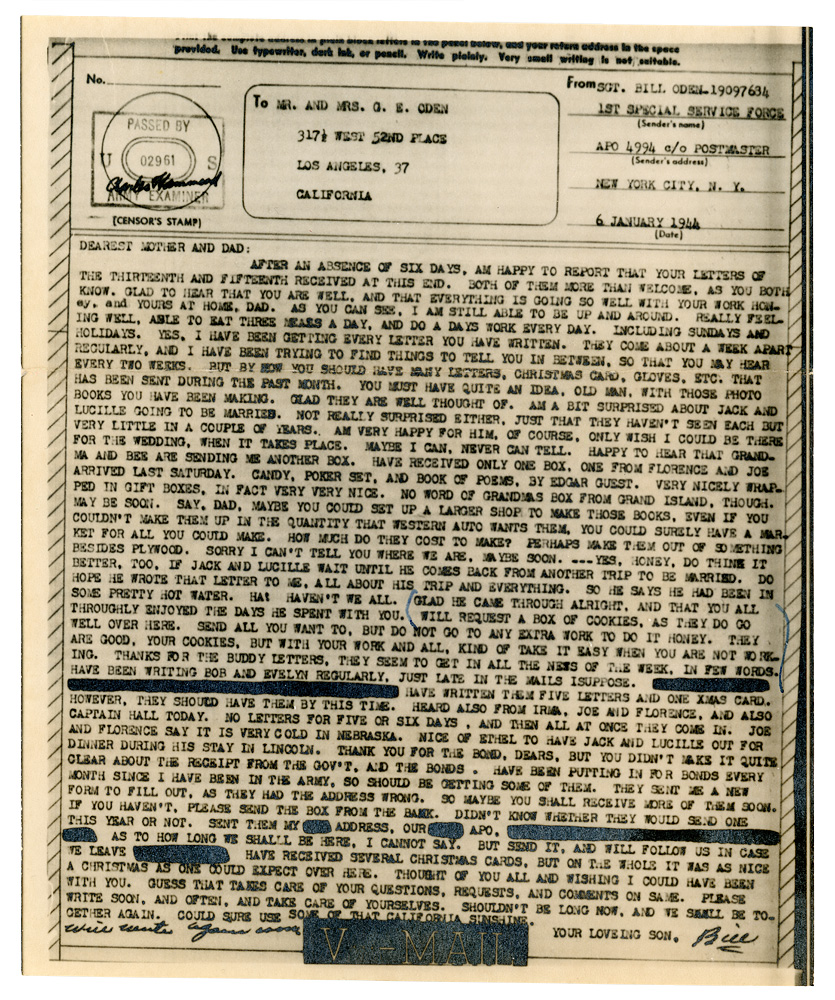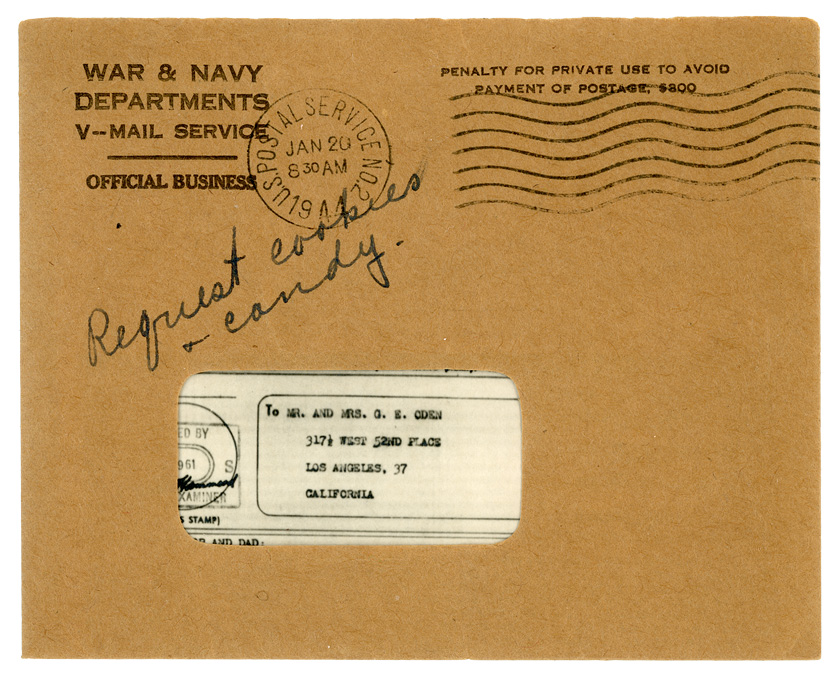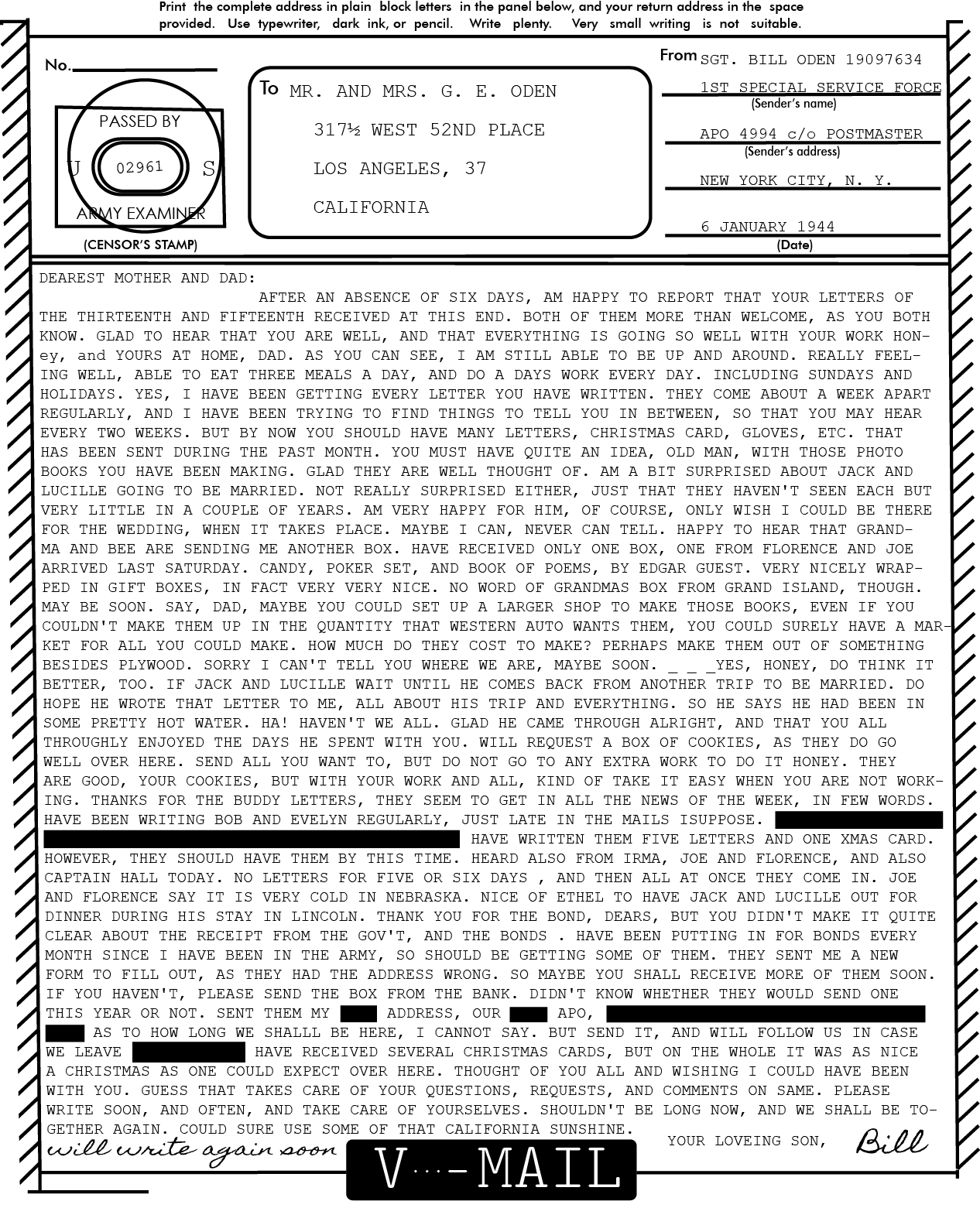The first wartime use of microfilm for sending postal messages was during the Franco-Prussian War, where pigeons were used to carry microfilm out of a besieged Paris (Yell & Fletcher, 2011, p. 121). In the 1920s and 1930s, Kodak demonstrated the possibility for combining microphotography and air travel in order to make international letter mail service faster – this was only seriously considered by the British following the onset of World War 2 (Yell & Fletcher, 2011, p. 121). The process, which transformed letters into “airgraphs”, was introduced in 1941 (Yell & Fletcher, 2011, p. 121). The British process produced one roll of film containing 1700 letters, weighing only 142 grams, far less than the 23 kilograms (50.7 pounds) that the original letters weighed (Yell & Fletcher, 2011, p. 121).
The volume of mail handled by the American postal system was around 28 billion pieces in 1940 (Litoff & Smith, 1990, p. 24). Likely as a result of this, the American government began to experiment with sending postal messages via microfilm in 1942 (Litoff & Smith, 1990, p. 22). The system was developed by Army Postal Director Colonel William Rose (Tapert, 1989, p. xviii). V-Mail (or “Victory Mail”) was based upon an 8.5 by 11 inch sheet of paper with space for around 700 words (Tapert, 1989, p. xviii). The stationary was specifically designed for the purpose (Litoff & Smith, 1990, p. 22). Using microphotography, 1600 V-Mail sheets could be transferred to a 90-foot roll of 16mm film (Tapert, 1989, p. xviii). A shipment of letters weighing 2575 pounds could be reduced to 45 pounds via microphotography (Litoff & Smith, 1990, p. 22). When the film reached its destination it was developed and, from the image of the original V-Mail stationary, a 4 by 5 inch print was produced and mailed in a window envelope (like the one below) (Tapert, 1989, p. xix). The original letters were not immediately destroyed in case the microfilm copies were lost or damaged on the way to their destination, which allowed them to be re-photographed (Litoff & Smith, 1990, p. 22). Litoff and Smith (1990, pp. 22-23) note an example of this in practice: “early in 1943, a Canadian bound RAF plane carrying 32 rolls of V-Mail, or 50,000 letters, from United States soldiers stationed in England and Ireland crashed in Newfoundland. The original letters were re-photographed and the new film was dispatched on a later plane.” The Army Signal Corps microfilmed the V-Mail letters which were subsequently distributed through the Army and Fleet Post Office Centers, ultimately being delivered via the United States postal system (Litoff & Smith, 1990, p. 23). Censorship was done to the originals prior to being microfilmed (showing up as the blacked-out portions, like the letter below), and “most officers in the service spent part of every day censoring and reading the mail from their troops” (Litoff & Smith, 1990, p. 23).
This particular V-Mail was written in Italy in January 1944 by Sergeant William C. Oden, who was in the First Special Service Force, a joint Canadian-American commando force referred to as “The Black Devils” by the Germans for the manner in which the unit fought in Italy and more popularly since then as “the Devil’s Brigade.” After Italy, the First Special Service Force served in combat in France before being disbanded in December 1944. According to Werner (2015, p. 4), the US–Anglo Alliance during World War II “recognized the need for specially trained soldiers that could go above and beyond tasks the standard infantryman could be expected to do” – this ultimately gave rise to a “fully integrated special operations force combining both Americans and Canadians – the First Special Service Force.” The soldiers were trained in “airborne, mountain, ski, amphibious, demolition, and hand-to-hand tactics, and would operate in small, multi-skilled combat elements” (Werner, 2012, p. 3). Sergeant Oden served with the First Special Service Force throughout almost it’s entire period of existence, joining during its initial period of training in Montana (and later Vermont) and staying with the unit until it’s disbandment in 1944. Sergeant Oden is listed on the published rosters (Burhans, 1947, p. 360; Morgensen, 2009) of the personnel of the First Special Service Force – it states that he is a resident of Los Angeles, California, which is also the destination for this V-Mail. Sergeant Oden was a participant in the mountain battles in Italy in December 1943, the subject of the 1968 film “The Devil’s Brigade.” Sergeant Oden also served several months at the Anzio beachhead and in the 1944 campaign in southern France. The letter itself is dated January 6th, 1944, the day of the battle for Monte Majo (Nadler, 2007, p. 148) and amongst a series of actions along the Germans’ defensive Bernhard (“B”) Line, which crossed the Italian peninsula at its narrowest point (Blumenson, 1988, p. 182), including also Monte di Difensa and Monte Sammucro. Sergeant Oden was awarded the Combat Infantryman’s Badge in February 1944, received several campaign stars, and appears to have received the Bronze Star medal early in 1945.
The letter sheet was typewritten, presumably on a headquarters typewriter. The book being referenced is impossible to identify based on the contents of the letter – Guest had written several books of poetry by 1944 (Academy of American Poets, 2014).
A corrected transcription of the V-Mail’s content:
Dearest Mother and Dad:
After an absence of six days, am happy to report that your letters of the thirteenth and fifteenth received at this end. Both of them more than welcome, as you both know. Glad to hear that you are well, and that everything is going so well with your work honey, and yours at home, dad. As you can see, I am still able to be up and around. Really feeling well, able to eat three meals a day, and do a days work every day. Including Sundays and holidays. Yes, I have been getting every letter you have written. They come about a week apart regularly, and I have been trying to find things to tell you in between, so that you may hear every two weeks. But by now you should have many letters, Christmas card, gloves, etc. That has been sent during the past month. You must have quite an idea, old man, with those photo books you have been making. Glad they are well thought of. Am a bit surprised about Jack and Lucille going to be married. Not really surprised either, just that they haven’t seen each but very little in a couple of years. Am very happy for him, of course, only wish I could be there for the wedding, when it takes place. Maybe I can, never can tell. Happy to hear that Grandma and bee are sending me another box. Have received only one box, one from Florence and Joe arrived last Saturday. Candy, poker set, and book of poems, by Edgar Guest. Very nicely wrapped in gift boxes, in fact very very nice. No word of Grandma’s box from grand island, though. Maybe soon. Say, dad, maybe you could set up a larger shop to make those books, even if you couldn’t make them up in the quantity that western auto wants them, you could surely have a market for all you could make. How much do they cost to make? Perhaps make them out of something besides plywood. Sorry I can’t tell you where we are, maybe soon. … yes, honey, do think it better, too. If Jack and Lucille wait until he comes back from another trip to be married. Do hope he wrote that letter to me, all about his trip and everything. So he says he had been in some pretty hot water. Ha! Haven’t we all. Glad he came through alright, and that you all thoroughly enjoyed the days he spent with you. Will request a box of cookies, as they do go well over here. Send all you want to, but do not go to any extra work to do it honey. They are good, your cookies, but with your work and all, kind of take it easy when you are not working. Thanks for the buddy letters, they seem to get in all the news of the week, in few words. Have been writing Bob and Evelyn regularly, just late in the mails I suppose. [CENSORED] have written them five letters and one Xmas card. However, they should have them by this time. Heard also from Irma, Joe and Florence, and also Captain Hall today. No letters for five or six days, and then all at once they come in. Joe and Florence say it is very cold in Nebraska. Nice of Ethel to have Jack and Lucille out for dinner during his stay in Lincoln. Thank you for the bond, dears, but you didn’t make it quite clear about the receipt from the gov’t, and the bonds. Have been putting in for bonds every month since I have been in the army, so should be getting some of them. They sent me a new form to fill out, as they had the address wrong. So maybe you shall receive more of them soon. If you haven’t, please send the box from the bank. Didn’t know whether they would send one this year or not. Sent them my [CENSORED] address, our [CENSORED] APO, [CENSORED] as to how long we shall be here, I cannot say. But send it, and will follow us in case we leave [CENSORED] have received several Christmas cards, but on the whole it was as nice a Christmas as one could expect over here. Thought of you all and wishing I could have been with you. Guess that takes care of your questions, requests, and comments on same. Please write soon, and often, and take care of yourselves. Shouldn’t be long now, and we shall be together again. Could sure use some of that California sunshine. Your loving son, Bill. Will write again soon.
References
Academy of American Poets. (2014, June 13). Edgar Guest. Retrieved from https://www.poets.org/poetsorg/poet/edgar-guest
Blumenson, M. (1988). United states army in World War 2, Mediterranean theater of operations, Salerno to Cassino. Washington, D.C.: US Government Printing Office.
Burhans, R. D. (1947). The first special service force: A war history of the North Americans, 1942-1944. Washington, D.C.: Infantry Journal Press.
Litoff, J. B., & Smith, D. C. (1990). “Will he get my letter?” Popular portrayals of mail and morale during World War II. The Journal of Popular Culture, 23(4), 21–43. doi:10.1111/j.0022-3840.1990.2304_21.x
Morgensen, E. (2009). Personnel roster of former members of the first special service force. Retrieved from www.firstspecialserviceforce.net/uploads/3/8/5/3/38534285/burhans_fssf_roster.doc
Nadler, J. (2007). A perfect hell: The true story of the Black Devils, the forefathers of the special forces. New York City, NY: Random House.
Tapert, A. (1989). Lines of battle: Letters from American servicemen, 1941-1945. New York, NY: Pocket Books.
Werner, B. (2012). First special service force 1942–44. Oxford, UK: Osprey Publishing.
Werner, B. (2015). Storming Monte la Difensa: The first special service force at the winter line, Italy 1943. Oxford, UK: Osprey Publishing.
Yell, S., & Fletcher, M. (2011). Airgraphs and an airman: The role of airgraphs in World War II family correspondence. History Australia, 8(3), 117-138. doi:10.1080/14490854.2011.11668391


